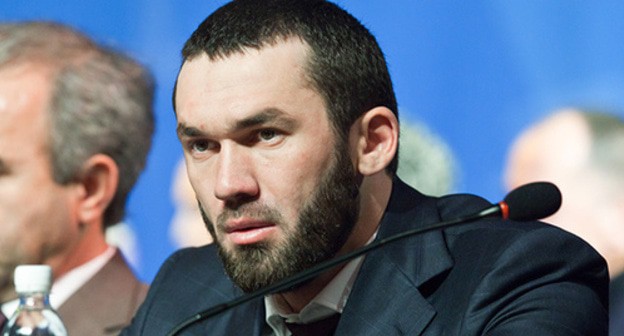Borga Kash
Borga Kash (Ingush The Grave of Borg/Borgan), a "saint's" mausoleum, the earliest of the surviving Muslim monuments in Ingushetia. It is situated in its foothills on the bank of the Sunzha northwest of the Plievo settlement, on a flat slope of a hill known as the Sheikh's Mountain (a 652-m high spur of the Sunzha Range). It dates back to 1405-06. In its architecture it is close to Majar mausoleums of the Golden Horde type. An Arabic inscription says the foreman's name is Giray.
Borga Kash has the shape of a regular prism topped with a hemisphere with a metal steeple. Its walls and cupola are built of solid yellowish stone (delivered from Georgia), carefully cut and accurately fitted. The mausoleum consists of two chambers: the ground and underground (funeral). It is 4.13x5.56 m in size at its basis and 3.18 m high. On one side, there is a portal with a lancet arch and a low entrance inside it (on both sides of the entrance is a raised ornamental pattern in the form of plaiting; above it are three raised Arabic inscriptions). The entrance leads into a room with smooth walls and a vault. There is an oval hole in the floor which serves as a connection to the ground floor of the mausoleum that has a rectangular basis, a semicircular vault, and four semicircular arches. There is a deep niche in the eastern wall (its function is not clear). The crypt was once painted inside: below was a yellow stripe with an ornamental pattern; above were painted flowers; and the vault was white, without paintings. The stone slab that covered the hole leading to the underground chamber and the stone bolster with Arabic epigraphy have been brought away. Apparently, Borga Kash was enclosed in a stone wall with an entrance on the eastern side.
According to the legend above the entrance, the name of the buried one is Bek-Sultan bin Hudaidad. Sources report on different versions of his ethnic background: Arab, Kabardian, Crimean Tatar, Kumyk (Kumuk/Khasav), Nogai, or Chechen. Perhaps, the original burial was not the only one: oral and written evidence of the number of those buried are contradictory; some sources don't specify it at all. The bodies were laid on plank beds arranged on the southern and northern sides of the underground chamber, in wooden coffins in colorful brocade with oriental ornaments (descriptions vary). The funeral accessories are mentioned briefly: decorations, copper coins. The name of Borga/Borgan in historiography is identified with the people known as the Borgans/Borogans/Braguns that used to inhabit those parts; it is also assumed Borga Kash may be the burial place of the family of the Bragunovs.
Borga Kash is covered with secrets, there are lots of legends about it. One has it the mausoleum was erected by beautiful Suv over the grave of her lover Borgan Beksultanov whose name has served as a basis for the mausoleum's name. Another has it the frames of the legendary Narts were in this place; they remained imperishable over 2,000 years, but began to "deteriorate" when the Russians came. Some claim the Ingush buried here those who were distinguished for their righteous life; others believe these are the "petrified" bodies of some people who happened to be in the crypt by chance. There is also another story: there lived an Arab sheikh in Ingushetia (or Tamerlane's associate Burhan Khan, according to another version). When he felt he would soon die, he wished to choose the place for his sepulcher: he rode a camel out into the steppe and let it choose. So where the camel stopped is now where Borga Kash is situated. They say fragrance formerly emanated from it, which smelled of ripe apples; and that it has a miraculous power. There also used to be talks about a treasure allegedly stored under the crypt, which caused more than one rapacious search. Borga Kash was completely ransacked in the last 30 years of the XIX cent.: the mummified body in 1876 was taken to Moscow and in the 1880s, having found no treasure, Molokans from Vladikavkaz, North Ossetia, poured a cask of oil into the cellar and set the mausoleum on fire (a Chechen legend says the treasure hunters were eliminated by hail and a storm).
Borga Kash is a very revered "holy" place in the N. Caucasus. On their return from Mecca in the early XIX cent., pilgrims brought a "holy" robe of white linen (or green cloth, according to another version) in which they wrapped the remains of "saint" Bek-Sultan. The mausoleum was taken very good care of: the natives initiated restoration works in the 1910s (cementing around the roof, the floor of the arch and the ground chamber; painting the outer walls in light-blue). In dry years they performed rituals near Borga Kash, asking for rain to be sent down. Women brought here their sick children for cure. On Muslim holidays they drove cattle to the mausoleum, for sacrifice. It was believed no one was allowed to enter the crypt: an awful wind would blow away everyone putting their foot there. Some believers went down to the underground chamber to pray.




![Tumso Abdurakhmanov. Screenshot from video posted by Abu-Saddam Shishani [LIVE] http://www.youtube.com/watch?v=mIR3s7AB0Uw Tumso Abdurakhmanov. Screenshot from video posted by Abu-Saddam Shishani [LIVE] http://www.youtube.com/watch?v=mIR3s7AB0Uw](/system/uploads/article_image/image/0001/18460/main_image_Tumso.jpg)